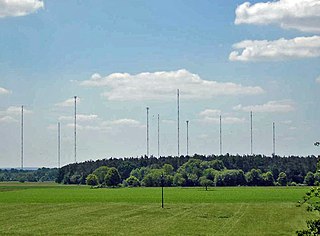
A genetic disorder is a genetic problem caused by one or more abnormalities formed in the genome. Most genetic disorders are quite rare and affect one person in every several thousands or millions. The earliest known genetic condition in a hominid was in the fossil species Paranthropus robustus, with over a third of individuals displaying Amelogenesis imperfecta.
A common carrier in common law countries is a person or company that transports goods or people for any person or company and that is responsible for any possible loss of the goods during transport. A common carrier offers its services to the general public under license or authority provided by a regulatory body. The regulatory body has usually been granted "ministerial authority" by the legislation that created it. The regulatory body may create, interpret, and enforce its regulations upon the common carrier with independence and finality, as long as it acts within the bounds of the enabling legislation.

An ensign is the national flag flown on a vessel to indicate citizenry. The ensign is the largest flag, generally flown at the stern (rear) of the ship while in port. The naval ensign, used on warships, may be different from the civil ensign or the yacht ensign. Large versions of naval ensigns called battle ensigns are used when a warship goes into battle. The ensign differs from the jack which is flown from a jackstaff at the bow of a vessel.

In telecommunications, a carrier wave, carrier signal, or just carrier, is a waveform that is modulated (modified) with an input signal for the purpose of conveying information. This carrier wave usually has a much higher frequency than the input signal does. The purpose of the carrier is usually either to transmit the information through space as an electromagnetic wave, or to allow several carriers at different frequencies to share a common physical transmission medium by frequency division multiplexing. The term is also used for an unmodulated emission in the absence of any modulating signal.

The flag of the Republic of China is the national flag of Taiwan, consisting of a red field with a blue canton bearing a white disc with twelve triangles surrounding it. The disc and triangles symbolize the sun and rays of light emanating from it respectively. In Chinese, the flag is commonly described as Blue Sky, White Sun, and a Wholly Red Earth to reflect its design attributes.

DCF77 is a German longwave time signal and standard-frequency radio station. It started service as a standard-frequency station on 1 January 1959. In June 1973 date and time information was added. Its primary and backup transmitter are located at 50°0′56″N 9°00′39″E in Mainflingen, about 25 km south-east of Frankfurt am Main, Germany. The transmitter generates a nominal power of 50 kW, of which about 30 to 35 kW can be radiated via a T-antenna.

Checked baggage is luggage delivered to an airline or train for transportation in the hold of an aircraft or baggage car of a passenger train. Checked baggage is inaccessible to the passenger during the flight or ride, as opposed to carry-on baggage.

Mandarin Airlines is a Taiwanese regional airline based in Taipei, Taiwan, whose parent company is China Airlines. The airline operates domestic and regional international flights, while its parent company focuses on international operations. Some charter services are also operated by the company. Its main hub is Taipei Songshan Airport with others at Taichung International Airport and Kaohsiung International Airport.
The International Convention for the Safety of Life at Sea (SOLAS) is an international maritime treaty which sets minimum safety standards in the construction, equipment and operation of merchant ships. The convention requires signatory flag states to ensure that ships flagged by them comply with at least these standards.

Uma-jirushi were massive flags used in feudal Japan to identify a daimyō or equally important military commander on the field of battle. They came into prominence during the Sengoku period. While many were simply large flags, not very different from sashimono or hata-jirushi, most were three-dimensional figures, more like kites, and in the shape of bells, gongs, umbrellas, or streamers.

The Welsh Dragon appears on the national flag of Wales. The oldest recorded use of the dragon to symbolise Wales is in the Historia Brittonum, written around AD 829, but it is popularly supposed to have been the battle standard of King Arthur and other ancient Celtic leaders. Its association with these leaders along with other evidence from archaeology, literature, and documentary history led many to suppose that it evolved from an earlier Romano-British national symbol. During the reigns of the Tudor monarchs, the red dragon was used as a supporter in the English Crown's coat of arms. The red dragon is often seen as symbolising all things Welsh, and is used by many public and private institutions. These include the Welsh Government, Visit Wales, the dragon's tongue is in use with the Welsh Language Society and numerous local authorities including Blaenau Gwent, Cardiff, Carmarthenshire, Rhondda Cynon Taf, Swansea, and sports bodies, including the Sport Wales National Centre, the Football Association of Wales, Wrexham A.F.C., Newport Gwent Dragons, and London Welsh RFC. The Welsh Dragon is also one of The Queen's Beasts.

A freight forwarder, forwarder, or forwarding agent, also known as a non-vessel operating common carrier (NVOCC), is a person or company that organizes shipments for individuals or corporations to get goods from the manufacturer or producer to a market, customer or final point of distribution. Forwarders contract with a carrier or often multiple carriers to move the goods. A forwarder does not move the goods but acts as an expert in the logistics network. These carriers can use a variety of shipping modes, including ships, airplanes, trucks, and railroads, and often do utilize multiple modes for a single shipment. For example, the freight forwarder may arrange to have cargo moved from a plant to an airport by truck, flown to the destination city, then moved from the airport to a customer's building by another truck.

Paratyphoid fever, also known simply as paratyphoid, is a bacterial infection caused by one of the three types of Salmonella enterica. Symptoms usually begin 6–30 days after exposure and are the same as those of typhoid fever. Often, a gradual onset of a high fever occurs over several days. Weakness, loss of appetite, and headaches also commonly occur. Some people develop a skin rash with rose-colored spots. Without treatment, symptoms may last weeks or months. Other people may carry the bacteria without being affected; however, they are still able to spread the disease to others. Both typhoid and paratyphoid are of similar severity. Paratyphoid and typhoid fever are types of enteric fever.

The county colours of an Irish county are the colours of the kit worn by that county's representative team in the inter-county competitions of the Gaelic Athletic Association (GAA), the most important of which are the All-Ireland Senior Football Championship and the All-Ireland Senior Hurling Championship. Fans attending matches often wear replica jerseys, and wave flags and banners in the county colours. In the build-up to a major match, flags and bunting are flown or hung from cars, buildings, telegraph poles, and other fixtures across the county, especially in those regions where GAA support is strong.

A merchant navy or merchant marine is the fleet of merchant vessels that are registered in a specific country. On merchant vessels, seafarers of various ranks and sometimes members of maritime trade unions are required by the International Convention on Standards of Training, Certification and Watchkeeping for Seafarers (STCW) to carry Merchant Mariner's Documents.

In heraldry and vexillology, a heraldic flag is a flag containing coats of arms, heraldic badges, or other devices used for personal identification.

The royal standards of England were narrow, tapering swallow-tailed heraldic flags, of considerable length, used mainly for mustering troops in battle, in pageants and at funerals, by the monarchs of England. In high favour during the Tudor period, the Royal English Standard was a flag that was of a separate design and purpose to the Royal Banner. It featured St George's Cross at its head, followed by a number of heraldic devices, a supporter, badges or crests, with a motto—but it did not bear a coat of arms. The Royal Standard changed its composition frequently from reign to reign, but retained the motto Dieu et mon droit, meaning God and my right; which was divided into two bands: Dieu et mon and Droyt.
















